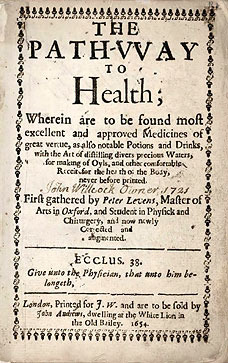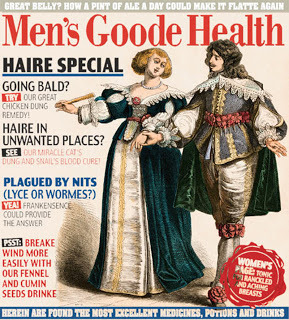A 17th century baldness cure
17th century baldness cure is chicken dung,
says Ye Olde Men's GoodeHealth
By OLINKA KOSTER, Daily Mail UK
Article source: http://www.dailymail.co.uk/health/article-478509/17th-century-baldness-cure-chicken-dung-says-Ye-Olde-Mens-Goode-Health.html#ixzz0ycprMtmr
 This edition says 1654, but the original
This edition says 1654, but the original edition would have been 1632.
These libraries carry the 228-page book.May 2007—In our age of gyms and jogging, dental floss anddeodorants, mouthwash and moisturisers, a chap can waft along with ease everyday feeling fit and fragrant. But back in 1654, with Oliver Cromwell ruling England,good health and grooming for men was somewhat more basic.
Then, no self-respecting male's medicine chest wasapparently complete without liberal supplies of cat's dung, snail's blood andchicken droppings - not to mention arsenic and brimstone.
Gruesome as they may sound, they were recommended asremedies for everything from bad breath to baldness, fatness to flatulence.
The fascinating array of potions and lotions is chronicledin The Path-Way To Health, a sort of 17th century version of Men's Healthmagazine, which has emerged from a private collection of antiquarian books.
One of the earliest medical journals written in English, itwill go up for auction in October [2007]. These are some of its suggestedcures:
BALDNESSAccording to the journal's author Peter Levens, the best wayto restore growth is to "Take the ashes of Culver-dung in Lye, and washthe head therewith. Also Walnut leaves beaten with Beares suet, restoreth thehaire that is plucked away. Also, the leaves and middle rinde of an Oak soddenin water, and the head washed therewith, is very good for this purpose."
For those brave enough to try the cure today, Culver-dungmay be translated as chicken dung, while "Lye" is a strong alkalinesolution of potassium salts made from ashes and used in soapmaking. Quite whereone might acquire "Beares suet" today is open to question.
 The Daily Mailillustration of what
The Daily Mailillustration of whatPathway to Health might look like in 2007
HAIR REMOVAL
To "take away haire" in unwanted places:"Take the shels of two Egges, beat them small, and stil them with a goodfire, and with that water annoynt the place; or else take hard Cats dung, dryit and beat it to powder, and temper it with strong Vineger, then wash theplace with the same, where you would have no haire to grow."Another cure for unwanted hair - which the author admits issomething of an experiment - reads: "Take the bloud of a Snaile without ashel, and it hindereth greatly the growing up of haire."Also take Labdanum (a sticky brown resin obtained fromcertain shrubs), the gum of a Ivie tree, Emmets Eggs, Arsenick and Vineger; andbinde it to the place where you wil have no haire to grow."One cure involves boiling "Frankensence and Barrowsgrease" into an ointment, while a remedy for nits suggests smearing thescalp with "the gall of a Calfe"."Take Wheat flower, and mingle the same with Honey, andlay it to the nails, and it wil help them."Where nails have been "rent from the flesh", amixture of "brimstone, arsnick and vinegar" can ease pain.
BAD BREATHThere are numerous suggestions for curing "stinkingbreath". One involves washing the mouth out with water and vinegar,followed by a concoction of aniseed, mint and cloves "sodden inwine".
BODY ODOURFor a "stench" under the armpits: "First,pluck away the haires of the arme holes, and wash them with white Wine androsewater that cassialigna has been sodden in, and use it three or fourtimes."
FLATULENCETo help "break wind in the belly," drink a mixtureof cumin seeds, fennel seeds and aniseeds in wine three times a day.
AND FOR THE LADIES...The journal includes some advice for women with "greatbellies", but makes no mention of whether it will also work onbeer-bellied men. However, like many of the cures, it appears fattening.
"Take an handful of Isop, ahandful of Herb-grace, a handful of Arsmart, and seeth all these herbs in aquart of Ale til it come to a pint, then preserve the same in a glass, and givethe woman so grived a quarter of a pint at once, first in the morning and lastat night."For "Womens paps (breasts)that arte rancled and be ful of ache," the author suggests: "TakeGrounsel, and two times as much of Brouswort, and wash them both, and stampthem, and temper them with stale Ale, and straine it through a cloth, and giveit to the Patient thereof first thing in the morning and last at night."
The journal's cover bills it as revolutionary, with asubtitle reading: "Wherein are to be found most excellent and approvedMedicines of great vertue, as also notable Potions and Drinks, with the Art ofdistilling divers precious Waters, for making of Oyls, and other comfortableReceit for the health of the body, never before printed."
The book also bears the name John Willcock, who owned the rarecopy in 1721 and made notes in its margins. It will go on sale at auctioneersBonhams in Oxfordin October [2007] and is listed to fetch a modest £400.
Book specialist Luke Batterham said: "It is afascinating volume - on the cusp of being an enlightened work and a quack book.It is a genuine attempt at a medicinal guide, accumulating worthwhile remediesfrom established sources with old wives' tales."
Published on February 06, 2012 15:15
No comments have been added yet.



